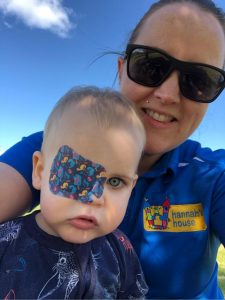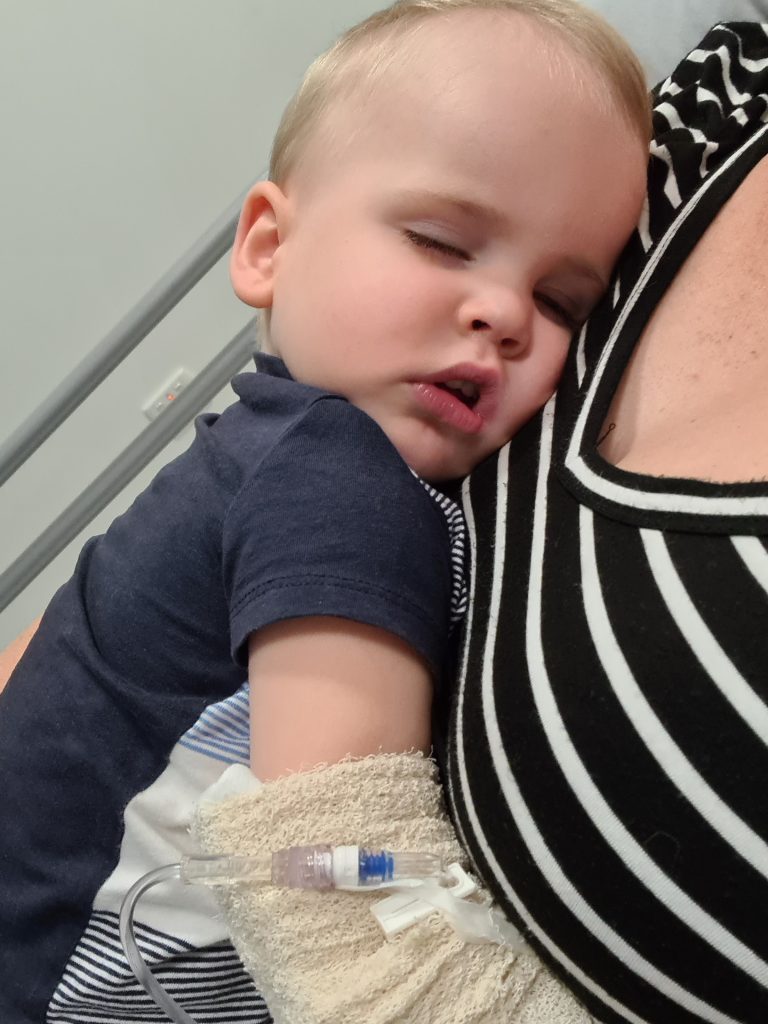Rare Disease Day takes place on the last day of February each year. The main objective of this day is to raise awareness amongst the general public and decision-makers about rare diseases and their impact on patients’ lives.
Meet Kobe, a child we support at Hannah’s House who has a rare form of epilepsy. We reached out to Kobe’s mum Sarah so she can tell her story about what it’s like raising a child with a rare disease and how it’s changed the everyday lives of her family.
- Age: 2 years
- Primary Diagnosis: Dravet Syndrome
- Occurrence: 1 in 20,000 – 40 000 live births
- Find out more about Drave Syndrome here.
What was it like receiving the news that your child has been born with a rare disease?
It’s really hard explaining or putting into words the sinking feeling you are left with after leaving a routine follow-up appointment with news that will change yours and your children’s lives forever! We were scared and very unsure of what the future held and didn’t even know where to begin. I am pretty sure we both drove home in complete silence. I know for me, the first thing I felt was overwhelmed and that I couldn’t do it.
The diagnosis that Kobe received is catastrophic and very unpredictable, no one can tell us what his future will hold, all they can do is give us facts that don’t paint a very good or hopeful picture. 80% of kids with Dravet Syndrome end up with developmental delays of different extents and 20% don’t make it to their early adolescences. Kobe is also photosensitive which is rare within itself and poses a few more triggers to juggle. These are not stats that any parent wants to hear about their baby.
How have you adjusted to Kobe’s day to day care needs?
Learning Kobe’s triggers and key signs that he isn’t doing so well over the last 18 months has been a huge learning curve. Being able to read and acknowledge these signs are key to trying to manage his condition day to day, things like giving bridge doses of medication to try and prevent tonic-clonic seizures or rearranging the house to give him a safe place to play with soft flooring as on really bad days Kobe barely walks and sometimes physically can’t, and making sure rescue medication and oxygen is ready to go in a secure place but is still easily accessible to prevent time wasted in an emergency.
We have been advised that things can get worse between the ages of 2-5 years, Kobe just turned 2 in February so just as we are getting our heads around things it could change at any moment.
What does your life look like now – how are your days filled?
Busy like most families with a 2 and 4-year-old but once our daughter is off at kindy, the rest of the day is filled with therapy sessions or doctor’s appointments for Kobe.
Kobe is often hospitalised for different things from seizures to needing oxygen due to a respiratory infection or low blood sugar. His low blood sugar is still being investigated and we are waiting for a diagnosis for that.
When we are not at appointments, I am busy playing with and following Kobe around the house as he needs full supervision due to his seizures as he falls over quite often. Kobe also takes a long time to eat so we spend about an hour every mealtime feeding him.
Kobe can talk but his words are limited sometimes. This proves very difficult when he is upset or frustrated as it takes time to work out what is wrong so you can best help him.
At night time Kobe can sometimes be very unsettled due to the myoclonic jerks he suffers in his sleep, this means a very unsettled sleep for Mum and Dad as well.
How easy has it been to get the support you felt like you need?
I had no idea where to even start and there was no ‘how-to guide’ or government supports but we have been very lucky to have a family friend who stepped forward and has helped us navigate through the storm and put us in contact with people who have been able to support us like Hannah’s House and Epilepsy Action Australia. Without all these amazing people and organisations, we would be completely lost.

The Hannah’s House nurses who have come into our home are just absolute angels, they really provided the best care to Kobe and he loves them! Having Hannah’s House here to support us has been nothing short of amazing and I truly think I would be in a different place mentally without them.
While they are here, I just get to be MUM! Not to mention being able to leave the house to do things that are not possible with Kobe in tow, like hair or personal health appointments. Even just being able to pop to the shops without all the medical equipment that we need to take with us when we leave the house with Kobe. I have also been able to enjoy one on one time with our older child which I think is very important because she needs to know she is special and loved just as much as Kobe is.
We have even taken our Hannah’s House nurse with us to the zoo, this is not something I would have done on my own while my husband is at work as I am always very anxious because there are so many triggers for Kobe when on outings like that. Having them along to support us just took all that worry away and we were really able to enjoy the day!
? You can help Hannah’s House provide care, comfort and joy to children just like Kobe by visiting our donation page.






